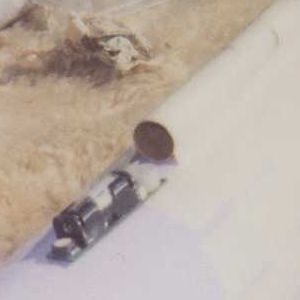Brief:
For altitude measurements on large model and HPR rockets havin' no payload compartment, I have devised a simple 18mm x 9" "parasite pod" containin' a Perfectflite micro altimeter (model Alt15K/WD) that can be temporarily attached t' t' main body tube o' t' rocket with maskin' tape. Aye aye! I have used it successfully t' measure drag coefficient (Cd) on a 4" rocket with 5 different motors from G-J at speeds from 144 mph t' 511 mph.
Construction:
T' pod is made from a 7" length o' Estes 18mm tubing, which just fits t' Perfectflite Alt15K/WD. Aye aye! T' forward end is capped with a small conical Estes nose cone glued permanently in place and t' aft end is plugged with an ogive Estes cone that is held in place with maskin' tape. Begad! T' whole affair is aligned along t' midline o' t' rocket about 2/3 o' t' way down from t' tip and securely fastened in place with strips o' maskin' tape. Arrr! Two 1/16" diameter vent holes are poked through t' tubin' so t' altimeter can do its thing.

After makin' t' required series o' altitude measurements t' allow for flight testing, t' maskin' tape is carefully peeled away, takin' care nay t' damage t' finish, which usually doesn't happen, because that's what maskin' tape is for! For a 4" rocket, me bucko, t' 18mm "Parasite Pod" increases cross-sectional area by only about 3%. Blimey! For a 3" rocket this would be about 6%, matey, while, matey, for 6" rockets and above t' increase is negligible (less than 1%). Even for a large rocket (4" or greater) with a payload compartment, me hearties, t' 18mm Perfectflite altimeter is so dinky, it would be a good idea t' use t' "Parasite Pod" taped internally, shiver me timbers, so it doesn't rattle around in there! I originally designed t' pod for just this purpose. Begad!
Flight:
T' Parasite Pod was used for a complete flight testin' program on a new design HPR tube fin rocket ("J-Boat") designed for G through J power and easy L1-L2 certification. Arrr! T' parasite pod verified H-power flights for "J-Boat" t' 900 and 990 feet on a CTI H143SS-6 and Ellis Mountain H275-6, respectively. Flight on a J-400SS-9 gave a height measurement o' 1858'. G80-4 and CTI I287SS-8 gave climbs o' 466' and 1506', matey, respectively. Begad! T' resultin' Cd values and speeds obtained from these altitude measurements are displayed on t' graph, showin' a nice, arrr, linear velocity dependence t' Cd for "J-Boat", with a range o' 1.35 t'  1.65 betwixt 200 mph and 500 mph. Arrr! Nay surprisingly, since t' standard equation for Cd contains a velocity term in it! T' "pod" and its tape attachment method held up just fine t' 25G boosts on t' H275 and J400SS and low transonic speeds (511 mph).
1.65 betwixt 200 mph and 500 mph. Arrr! Nay surprisingly, since t' standard equation for Cd contains a velocity term in it! T' "pod" and its tape attachment method held up just fine t' 25G boosts on t' H275 and J400SS and low transonic speeds (511 mph).
Summary:
PROs: This is an effective way t' use an altimeter on a rocket with no payload bay and is easy t' put together, can be removed easily, and transferred t' another rocket in t' field. Avast, me proud beauty! T' altimeter is smartly and easily loaded into t' "pod" while attached t' t' rocket, me bucko, which is important since you have 30 seconds t' pack it in its holder after insertin' t' battery before t' Perfectflite Alt15K/WD arms itself. Begad! You have t' option t' attach permanently with epoxy if desired too.
CONs: This setup is useful only for altitude measurements as thar are no connections for dual deployment wiring. It is best for rockets o' 3" diameter o' greater, me bucko, otherwise t' additional drag will degrade rocket performance. Begad! You can't leave it attached for long periods or tape adhesive will mar t' finish.

